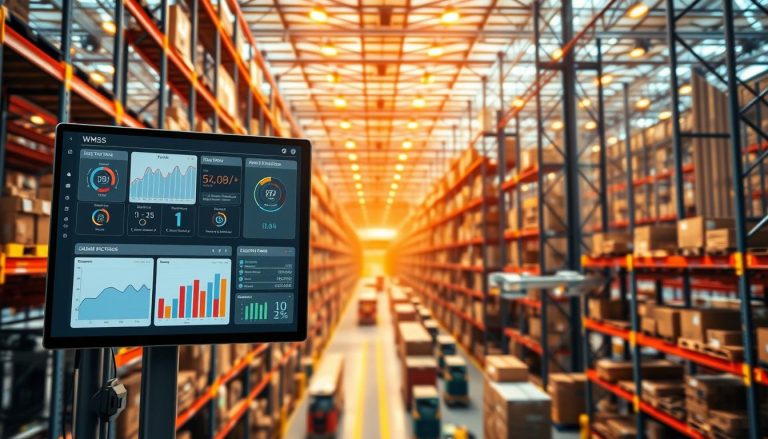Top Third Party Logistics Companies in the US
U.S. shippers are dealing with tight budgets, unpredictable demand, and increasing service expectations. This report compares top third party logistics companies by revenue, capabilities, and reliability. It aims to help leaders align logistics outsourcing with their goals. The analysis is based on Armstrong & Associates data for 2023–2025 and Transport Topics’ 2025 Top 100 Logistics Companies.
The review covers a wide range of 3PL services, including fulfillment, freight brokerage, forwarding, and contract logistics. It looks at major players like Amazon, C.H. Robinson, GXO Logistics, J.B. Hunt, and UPS Supply Chain Solutions. It also examines Expeditors International, Ryder Supply Chain Solutions, XPO, Kuehne + Nagel, and DHL Supply Chain.
Market shifts due to mergers and acquisitions are also discussed. For example, RXO plans to buy Coyote Logistics from UPS, and DSV will acquire DB Schenker. This information is vital for understanding the current market landscape.
The report offers a practical framework for evaluating supply chain management providers. It considers factors such as industry specialization, network coverage, SLAs, technology stack, cost structure, and compliance. It also highlights the best-fit options for direct-to-consumer brands, including GoBolt, ShipBob, and Red Stag Fulfillment.
The ultimate goal is to provide verified facts and balanced analysis. This way, teams can make informed decisions, reduce risk, and improve service efficiency. By comparing leading third party logistics companies and using evidence-based benchmarks, decision-makers can choose the right logistics outsourcing strategy. This supports scale, visibility, and margin discipline.
What 3PLs Do: Core services, benefits, and when to outsource
Third-party logistics providers handle the core tasks of freight, storage, and fulfillment. This allows shippers to focus on growth. Companies like Amazon, C.H. Robinson, GXO Logistics, UPS Supply Chain Solutions, and Expeditors use their extensive networks and advanced systems. They deliver consistent service levels at a large scale.
Defining a 3PL: Transportation, warehousing, and fulfillment as outsourced services
A 3PL manages transportation and distribution services, third-party warehousing, and order fulfillment. They handle inventory management, pick and pack, returns processing, freight brokerage, and customs brokerage. These tasks form an integrated stack, often provided as contract logistics solutions.
Providers align facility locations, carrier contracts, and systems to meet demand patterns and service targets. This ensures an efficient and reliable service.
Benefits for shippers: Cost savings, scalability, visibility, and speed-to-customer
Shippers benefit from cost savings through network density and economies of scale. Flexible capacity supports seasonal peaks without fixed overhead. Standardized SOPs stabilize service performance.
Modern WMS and TMS platforms enhance visibility with real-time tracking and exception alerts. Faster cycle times and zone-optimized placement improve speed-to-customer. This enables two-day or next-day delivery across major metros.
Common 3PL offerings: Third-party warehousing, freight brokerage, and contract logistics solutions
- Third-party warehousing: shared or dedicated facilities, value-added services, and reverse logistics for DTC and B2B flows.
- Freight brokerage: access to vetted carriers across truckload, LTL, intermodal, air, and ocean for balanced cost and transit time.
- Contract logistics solutions: engineered processes, automation, and labor planning tailored to SKU profiles and order mix.
- Transportation and distribution services: route optimization, cross-dock, final-mile coordination, and appointment scheduling.
When to partner: Indicators it’s time to leverage logistics outsourcing
Outsourcing is practical when orders grow faster than facility throughput or logistics costs per unit increase. Missed SLAs, late cutoffs, or high split-ship rates indicate network and process gaps.
Expansion into new regions or cross-border lanes increases compliance and carrier complexity. Specialized needs, such as temperature control or oversized handling, also suggest outsourcing. This path leads to reliable performance and scalable capacity.
Market landscape in 2025: Growth headwinds, trade uncertainty, and e-commerce demand
North America’s largest 3PLs faced a slow freight rebound and unclear trade outlook in 2025. The uncertainty over new tariffs and shifting freight patterns made demand planning and lane balance challenging. Despite this, e-commerce volume continued to favor faster fulfillment and parcel efficiency.
Transport Topics’ 2025 Top 100 showed mixed results. Most firms saw modest 2024 gains, but about one-third experienced lower revenue. Amazon topped the list, with over $156 billion in 2024 seller services revenue. GXO ranked third with $11.7 billion, highlighting the resilience of contract logistics.
Consolidation reshaped the rankings. RXO acquired Coyote Logistics, and Schneider expanded its dedicated operations by acquiring Cowan Systems. NFI purchased brokerage assets from Transfix. DSV’s agreement to acquire DB Schenker, valued at $15.9 billion, signals a scale-building move that could reset North American competition.
Shippers now face tighter procurement cycles and uneven bid activity. To manage volatility, many partner with multi-modal providers. These partnerships blend transportation and distribution services with automation and network optimization. The goal is to achieve capacity stability while meeting e-commerce expectations.
| Indicator | 2024–2025 Signal | Implication for 3PL services | Key Players Mentioned |
|---|---|---|---|
| Freight Demand | Slow recovery with regional imbalances | Supply chain management providers adjust lanes and assets to protect margin | J.B. Hunt, UPS Supply Chain Solutions |
| Trade Policy | Tariff uncertainty and routing shifts | Integrated logistics providers expand customs and compliance support | DSV, DB Schenker, Expeditors |
| E-commerce Velocity | Stable demand for fast fulfillment | Transportation and distribution services prioritize parcel and final mile | Amazon, DHL Supply Chain |
| Consolidation | Active M&A reshapes competitive set | Broader networks and bundled 3PL services for shippers | RXO, Coyote Logistics, Schneider, Cowan Systems, NFI, Transfix |
| Contract Logistics | Resilient volumes and automation gains | Supply chain management providers invest in robotics and WMS | GXO, XPO |
As networks adapt, leaders must balance cost discipline with service quality. The priority is clear: protect speed-to-customer while managing risk across multimodal capacity, cross-border flows, and data-driven planning delivered by integrated logistics providers.
Top U.S. players by revenue: Who leads and why it matters
In the U.S., the top logistics players have a significant impact on the industry. Their scale influences carrier access, network density, and pricing. These leaders offer a wide range of services, from transportation and distribution to contract logistics and forwarding. Their success highlights the importance of aligning capabilities with revenue performance.
Amazon: National fulfillment, last‑mile scale, and AI‑driven automation
Amazon leads with an estimated $156,146 million in gross logistics revenue. Its nationwide fulfillment network, powered by robotics and AI, streamlines pick, pack, and returns across over 1,000 U.S. sites. This sets a high standard for third party logistics companies in terms of service.
C.H. Robinson: Freight brokerage strength and multimodal capacity
C.H. Robinson reports about $16,848 million, driven by its truckload, LTL, ocean, and air brokerage services. With 300+ offices, it balances capacity and price across various modes. It is recognized among freight forwarding companies for its strong customs and temperature-controlled coverage.
GXO Logistics: Contract logistics, robotics, and reverse logistics
GXO posts roughly $11,709 million from engineered warehousing, automation, and returns management. Robotics, goods-to-person systems, and data-led labor planning enhance its performance. Its role among integrated logistics providers is critical for complex, multi-site operations.
J.B. Hunt: Intermodal networks and digital freight matching
J.B. Hunt generates near $11,403 million by combining rail intermodal with dedicated and brokerage services. Its digital freight tools match loads at scale and support final-mile delivery. These assets improve transportation and distribution services for enterprise shippers.
UPS Supply Chain Solutions: Forwarding, warehousing, and healthcare logistics
UPS Supply Chain Solutions posts about $11,165 million. It integrates forwarding, warehousing, and customs brokerage with specialized healthcare logistics. This breadth places it among integrated logistics providers with global compliance and cold-chain proficiency.
Expeditors International: Air and ocean forwarding with customs expertise
Expeditors records roughly $10,808 million driven by air and ocean forwarding. Strong brokerage and purchase-order management support complex supply chains. It is recognized among freight forwarding companies for disciplined cost control and visibility.
Ryder Supply Chain Solutions: Dedicated transportation and eCommerce fulfillment
Ryder reports near $9,693 million by combining dedicated fleets, omnichannel fulfillment, and value-added services. Its sites support DC operations, returns, and kitting. Shippers use Ryder to align transportation and distribution services with inventory strategy.
XPO and Kuehne + Nagel: LTL, contract logistics, and integrated logistics providers
XPO posts about $8,955 million through LTL, last-mile heavy goods, and contract logistics. Kuehne + Nagel in the U.S. ranks near $8,773 million, blending forwarding with warehousing. Together, they illustrate how integrated logistics providers merge asset-light forwarding with engineered operations.
DHL Supply Chain: Distribution and global supply chain services
DHL Supply Chain reports around $7,925 million from warehousing, distribution, and eCommerce fulfillment. Its engineered networks, labor planning, and automation drive reliable SLAs. The brand sits at the nexus of third party logistics companies and freight forwarding companies through group synergies.
Revenue leadership signals buying power, resilience, and capital for technology. These attributes translate into reliable capacity, better rates, and regulated flows, even when cross-border rules tighten.
How the Largest Differ: Scale, Innovation, and Global Reach
Leading supply chain management providers stand out due to their network density, advanced technology, and strict compliance. These factors significantly influence service quality and support for logistics outsourcing in complex systems.
Scale and reliability: Network density, transportation and distribution
Scale is key to building reliable capacity. Amazon boasts over 1,000 U.S. facilities, with a strong focus on the last mile. GXO manages 970+ sites, while Kuehne + Nagel has more than 1,400 locations worldwide. This extensive network stabilizes transportation and distribution services, catering to various industries.
High network density minimizes dwell and transit variance. It also supports multi-node inventory placement, enabling quick replenishment during peak cycles through logistics outsourcing.
Innovation and visibility: Automation, AI platforms, real-time tracking
Technology plays a critical role in improving control and speed. Amazon uses robotics and AI-driven orchestration on a large scale. GXO invests in automation and analytics across its warehouses. C.H. Robinson’s Navisphere coordinates multimodal moves with real-time tracking and performance dashboards.
Top providers standardize data flows, unify exceptions, and integrate forecasting. These tools enhance contract logistics solutions and streamline tendering, consolidation, and delivery windows.
Global reach and compliance: Cross-border logistics and customs brokerage
Expeditors, DHL, Kuehne + Nagel, DSV, and DB Schenker offer integrated cross-border programs with licensed customs brokerage. Their networks connect origin, gateway, and destination activities under one governance model.
This depth supports trade documentation, valuation, and sanctions screening. It enables logistics outsourcing that meets duty optimization goals while protecting throughput during regulatory changes.
Cost efficiency and trust: Economies of scale and audited processes
Large operators leverage buying power and shared infrastructure to reduce costs. Audited processes, standardized SOPs, and quality systems strengthen reliability and risk controls.
For shippers, this means stable pricing bands and repeatable outcomes across transportation and distribution services. It also enhances accountability when partnering with supply chain management providers.
| Differentiator | Representative Leaders | Operational Advantage | Shipper Impact |
|---|---|---|---|
| Network Scale | Amazon, GXO, Kuehne + Nagel | Dense facility coverage and last‑mile reach | Shorter lead times and resilient capacity via logistics outsourcing |
| Technology & Visibility | Amazon, GXO, C.H. Robinson | Automation, AI platforms, and real-time tracking | Fewer exceptions and better OTIF performance |
| Global Compliance | DHL, Expeditors, DSV, DB Schenker | Customs brokerage and end-to-end cross-border control | Lower clearance risk and consistent international flows |
| Cost & Governance | UPS Supply Chain Solutions, Ryder, XPO | Economies of scale with audited processes | Competitive rates and standardized contract logistics solutions |
Emerging Dynamics: M&A Moves and Rankings Shifts Shaping U.S. 3PLs
Consolidation is reshaping the U.S. 3PL landscape. RXO acquired Coyote Logistics from UPS in September for over $1 billion. RXO, ranked No. 16, now has $4.5 billion in 2024 revenue. Coyote’s revenue growth suggests RXO’s ranking will rise as shippers seek integrated services.
Schneider, ranked No. 18, expanded its dedicated fleet by buying Cowan Systems for $390 million. This move shows Schneider’s commitment to private fleet conversions, a strategy to meet the demand for contract carriage. NFI, ranked No. 22, bought Transfix’s brokerage business. This move aligns broker tech with larger supply chain providers, enabling network-scale deployment.
At the global level, DSV agreed to buy DB Schenker from Deutsche Bahn for about $15.9 billion. This deal will combine two freight forwarding giants, potentially reshaping North American logistics. The integration could impact routing, compliance, and service design.
Rankings are changing. GXO jumped to No. 3 in 2025 with $11.7 billion in revenue. Amazon remains No. 1, and C.H. Robinson is No. 2. Newcomers like De Well Group and Bridgeway Connects are entering the market, bringing fresh capabilities in brokerage and dedicated carriage.
These changes reflect the integration of asset-light brokerage with targeted contract operations. Macroeconomic pressures, including a slow freight recovery and tariff risks, are driving these shifts. Shippers are diversifying their supply chains, often using 3PL services to manage demand fluctuations.
Freight forwarding companies with strong customs and trade expertise are gaining traction. They are helping shippers navigate rerouting and de-risking strategies. In this context, supply chain management providers are focusing on data accuracy, audited processes, and modal flexibility.
Integrated logistics providers that can adapt between dedicated fleets, brokerage, warehousing, and returns management are leading the way. They are setting the pace as procurement teams reevaluate contracts and service tiers.
Third Party Logistics Companies for DTC Brands: Best-fit Options and Capabilities
DTC brands prioritize speed, scalability, and transparent pricing. The ideal partner combines third-party warehousing with transportation and distribution. This ensures quick delivery and accurate inventory management. These companies leverage logistics outsourcing to handle order surges while safeguarding profit margins.
GoBolt: Coast-to-coast fulfillment, multi-carrier rates, and next-day shipping
GoBolt has nodes on the East Coast, West Coast, and the central U.S., enabling next-day delivery in key cities. Its WMS offers real-time inventory tracking. A diverse fleet supports parcel and middle-mile transport. With over 15 carriers, it secures competitive rates and reliable service.
It provides third-party warehousing, inventory management, custom packaging, and bundling. Brands benefit from rapid setup and unified SLA tracking through a single portal.
ShipBob: Nationwide network for consistent 2‑day delivery and platform integrations
ShipBob operates over 50 U.S. centers for consistent two-day delivery. It integrates with Shopify, BigCommerce, and WooCommerce for streamlined order and return processes. Pricing is clear, making it easier for growing brands to outsource logistics.
The network supports multi-node allocation, robust inventory tracking, and standardized KPIs for scaling DTC brands. It balances cost and service across different zones.
Red Stag Fulfillment: Heavy, oversized, and fragile SKU expertise
Red Stag Fulfillment specializes in handling bulky and fragile items with same-day service and accuracy guarantees. Its facilities are designed for pallet-intensive work, white-glove handling, and secure storage. This approach reduces damage rates and protects profit on high-value items.
For complex freight, it offers specialized packaging and precise picking. This extends the value of third-party warehousing, reducing total landed cost.
Buske Logistics: Warehousing depth and cross-border support
Buske Logistics provides scalable storage and value-added services for mid-sized to large brands. It supports U.S.–Canada flows with customs management and freight forwarding. Shippers get end-to-end control through coordinated services.
The company designs tailored programs for seasonality, co-packing, and retailer compliance. It aligns inventory strategy with demand patterns.
Atomix Logistics and OTW Shipping: Tech-driven scalability and tailored solutions
Atomix Logistics uses technology to offer real-time inventory tracking and efficient fulfillment for startups. It provides reverse logistics and clear SLAs for customer satisfaction while keeping costs predictable. OTW Shipping creates customized shipping programs and cross-border pathways for international growth.
Both companies enable logistics outsourcing with configurable workflows, analytics dashboards, and proactive exception management.
Good Company Ships: Sustainability-focused fulfillment options
Good Company Ships focuses on eco-friendly operations, using recyclable materials and optimized cartonization. It offers flexible fulfillment with temperature-controlled storage and carrier partnerships. This balances speed with environmental impact.
For DTC brands, these practices integrate with third-party warehousing and route planning. They reduce waste while maintaining delivery performance.
- Decision drivers: delivery speed targets, SKU profile, cross-border needs, and pricing transparency
- Key capabilities: multi-node networks, WMS visibility, packaging services, and reliable transportation and distribution services
- Use case fit: brands adopting logistics outsourcing to scale without fixed asset burden
Service Lines Explained: Matching 3PL Services to Your Operating Model
Core 3PL services align with a business’s production, storage, and shipping processes. For manufacturers and omnichannel retailers, contract logistics solutions offer stability. These include dedicated sites, engineered labor, and value-added services. Companies like GXO, DHL Supply Chain, Kuehne + Nagel, and Ryder use automation and reverse logistics to support production and store replenishment.
Freight brokerage and multimodal capacity serve as a flexible valve for businesses facing demand fluctuations. C.H. Robinson, J.B. Hunt, XPO, TQL, and RXO connect shippers with vetted carriers for various transportation modes. They balance rates with service reliability, essential during seasonal peaks and promotions.
For cross-border flows, air and ocean forwarding with customs expertise is critical. Expeditors, DHL, Kuehne + Nagel, and DSV manage end-to-end 3PL services. They handle documentation, bonded movements, and door-to-door control, ensuring compliance with evolving trade rules.
E-commerce operations thrive with nationwide nodes and fast cutoffs. Amazon’s fulfillment network, ShipBob’s 50+ facilities, and GoBolt’s coast-to-coast coverage enable fast delivery. These third-party warehousing options integrate order routing, returns processing, and value-added kitting for promotions and product drops.
DTC brands require specialized handling and tailored technology. Red Stag supports heavy or fragile SKUs with precise receiving and packaging. Good Company Ships focuses on lower-impact materials and route optimization for greener outcomes. Atomix and OTW provide configurable systems for startups and midsize brands, enabling rapid onboarding and API-driven workflows.
Service line alignment should reflect SKU profiles, demand volatility, origin-destination pairs, and compliance needs. High-mix inventories often benefit from contract logistics solutions with advanced WMS.
Volatile lanes align with brokerage-led transportation and distribution services. Cross-border portfolios require forwarding depth, while fast-turn DTC catalogs benefit from scalable third-party warehousing under integrated 3PL services.
Selection criteria: How to Choose a U.S. 3PL That Fits Your Growth Plan
Choosing a third party logistics provider should be based on solid evidence. It should align with your forecasted volume, channel mix, and service goals. Use a structured scorecard to compare companies under real demand scenarios and during seasonal peaks. It’s also important to assess their resilience to tariff shifts and freight cycles, and their ability to adjust labor and transportation capacity.
Industry specialization: E-commerce, temperature-controlled, automotive, and more
Before focusing on price, ensure the provider has the right expertise for your industry. For e-commerce, consider Amazon, ShipBob, and GoBolt for their fast nationwide fulfillment and order accuracy. For freight, evaluate C.H. Robinson, TQL, and RXO for their extensive multimodal reach.
For contract logistics with automation, compare GXO, DHL Supply Chain, and Ryder on their use of robotics, reverse logistics, and labor standards. For forwarding plus customs, look at Expeditors, Kuehne + Nagel, and DSV for their brokerage skills and trade compliance. Choose integrated logistics providers for end-to-end orchestration.
Network coverage and SLAs: Facility locations, cutoffs, and on-time targets
Ensure the provider’s network matches your demand density and service goals. Check their two-day and next-day zones, ship cutoffs, and weekend processing. Amazon, GXO, and ShipBob have different coverage models.
Require historical data on on-time performance, dock-to-stock cycle time, and order-to-ship metrics. Ask providers to show lane-level transit reliability during peak times.
Technology stack: WMS/TMS, integrations, and shipment visibility
Require real-time inventory sync, order orchestration, and carrier performance analytics. Review the maturity of their WMS/TMS, API and EDI integrations, and exception management. C.H. Robinson’s Navisphere and DTC-focused WMS at GoBolt and ShipBob show their capabilities.
Ensure SKU-level traceability, ASN compliance, and proactive alerts. Request sandbox testing to confirm data quality before going live with logistics outsourcing.
Cost structure: Fulfillment fees, storage, transportation, and value-added services
Model total landed cost, not just pick-and-pack. Include storage by cubic foot, parcel and LTL rates, surcharges, and value-added services. Leverage economies of scale from large providers while keeping rates transparent.
Stress-test quotes with realistic order profiles, dimensional data, and seasonal spikes. Request lane-level benchmarks and audit rights from integrated logistics providers.
Risk and compliance: Security, certifications, and trade regulations
Verify facility security, audited processes, and certifications such as ISO, C-TPAT, FDA for relevant sectors, and PCI for payment-adjacent workflows. Confirm disaster recovery plans, data governance, and cyber controls.
For cross-border flows, require in-house or partnered customs brokerage, denied-party screening, and tariff classification accuracy. Select providers that can adapt compliance programs as regulations evolve.
- Decision horizon: 3–5 years, with clear volume and service milestones.
- Operational KPIs: on-time ship, order accuracy, dock-to-stock, inventory accuracy, and cost per order.
- Scalability proof: labor ramp timelines, carrier diversification, and overflow site activation.
Global Context: Where U.S. Leaders Sit in the Worldwide 3PL Hierarchy
In the global logistics arena, U.S. leaders face stiff competition. Rankings from Armstrong & Associates (2025) highlight the top players. These include freight forwarding companies and integrated logistics providers, dominating ocean, air, and contract logistics. Their 3PL services bridge the gap from factory to final mile, catering to shippers’ needs for compliance and visibility.

Global giants with U.S. scale: Amazon, DHL, Kuehne + Nagel, and DSV
Amazon leads the world with $156,146 million in logistics revenue, thanks to its vast fulfillment and last-mile network. DHL Supply Chain & Global Forwarding follows with $33,542 million, blending contract logistics with extensive corridors.
Kuehne + Nagel posts $30,283 million, with significant air and ocean volumes. DSV reports $23,335 million and continues to grow through acquisitions. These giants influence rates, service levels, and modal choices for North American shippers.
Forwarding powerhouses vs. contract logistics specialists
Forwarding leaders like DHL Global Forwarding, Kuehne + Nagel, DSV, and DB Schenker excel in air and sea networks, customs, and trade lanes. Their strength lies in carrier procurement, capacity pooling, and risk control across borders.
Contract logistics specialists, such as GXO and DHL Supply Chain, focus on automated distribution, e-commerce fulfillment, and reverse flows. In the U.S., C.H. Robinson ($16,848 million), GXO ($11,709 million), J.B. Hunt ($11,403 million), UPS Supply Chain Solutions ($11,165 million), Expeditors ($10,808 million), Ryder ($9,693 million), and XPO ($8,955 million) maintain scale within 3PL services. They align with either forwarding or warehousing-led models.
Integrated ocean-to-door models and cross-border enablement
End-to-end structures are gaining traction. Maersk Logistics advances ocean-to-door solutions, merging vessel capacity with inland execution. DHL blends forwarding and contract logistics to streamline handoffs and standardize data across modes.
Such designs offer supply chain management providers a unified governance layer for trade compliance, documentation, and KPI tracking. As consolidation quickens, freight forwarding companies may gain bargaining power while expanding U.S. warehousing footprints.
| Company | Primary Strength | 2025 Revenue (USD Millions) | Model Classification | North America Relevance |
|---|---|---|---|---|
| Amazon | National fulfillment and last‑mile scale | 156,146 | Integrated logistics providers | High: e-commerce and retail distribution |
| DHL Supply Chain & Global Forwarding | Contract logistics plus global forwarding | 33,542 | Hybrid: 3PL services across modes | High: distribution, healthcare, cross-border |
| Kuehne + Nagel | Air/ocean capacity and customs | 30,283 | Freight forwarding companies | High: trans-Pacific and trans-Atlantic lanes |
| DSV | Global forwarding scale; M&A expansion | 23,335 | Freight forwarding companies | Rising: end-to-end growth via acquisitions |
| C.H. Robinson | Brokerage and multimodal capacity | 16,848 | 3PL services | High: truckload, LTL, and cross-border |
| GXO Logistics | Automated contract logistics | 11,709 | Supply chain management providers | High: e-commerce, returns, value-add |
| J.B. Hunt | Intermodal and digital brokerage | 11,403 | 3PL services | High: rail-road integration and drayage |
| UPS Supply Chain Solutions | Forwarding, warehousing, healthcare | 11,165 | Integrated logistics providers | High: regulated and temperature-controlled |
| Expeditors International | Air/ocean forwarding and customs | 10,808 | Freight forwarding companies | High: compliance and corridor control |
| Ryder Supply Chain Solutions | Dedicated transport and fulfillment | 9,693 | Supply chain management providers | High: automotive, industrial, retail |
| XPO | LTL and contract logistics | 8,955 | 3PL services | High: national LTL and distribution |
Conclusion
The U.S. 3PL sector in 2025 is marked by scale, technology investment, and strategic consolidation. Amazon, C.H. Robinson, GXO, J.B. Hunt, and UPS Supply Chain Solutions lead with e-commerce fulfillment and contract logistics. Despite slow freight recovery and tariff uncertainty, top third party logistics companies are investing in automation and AI. This move aims to stabilize costs and enhance service reliability.
Mergers and acquisitions are reshaping the market, creating more integrated networks. Deals like RXO–Coyote and Schneider–Cowan Systems highlight this trend. DSV–DB Schenker’s acquisition also points to a focus on digital execution and integrated capacity. For direct-to-consumer brands, specialized providers like GoBolt and ShipBob offer tailored solutions, including fast delivery and eco-friendly options.
Choosing the right logistics partner is key. It involves matching order profiles and service needs with the provider’s capabilities. Evaluating a provider’s technology, locations, and services is essential. This ensures cost savings, faster delivery, and increased resilience in both domestic and international markets.
The future of logistics outsourcing hinges on careful selection and measurable results. By aligning with the strengths of leading third party logistics companies, shippers can gain scalable capacity and clear visibility. This approach is critical in volatile demand cycles and shifting trade landscapes.
FAQ
What does a third-party logistics (3PL) company do?
A 3PL offers a range of services, including transportation and distribution, warehousing, and fulfillment. They also handle returns, freight brokerage, and customs brokerage. Leading providers use advanced technology and global networks to manage all aspects of logistics.
Which third party logistics companies lead the U.S. market in 2025?
According to Armstrong & Associates and Transport Topics, Amazon leads the market by gross logistics revenue. C.H. Robinson, GXO Logistics, and J.B. Hunt follow closely. UPS Supply Chain Solutions ranks fifth. Other top companies include Expeditors International, Ryder Supply Chain Solutions, and XPO.
Kuehne + Nagel and DHL Supply Chain also make the list. They excel in fulfillment, freight brokerage, forwarding, and contract logistics.
When should a shipper consider logistics outsourcing to a 3PL?
Shipments should consider 3PL services when they experience rapid growth or rising costs. Limited visibility and cross-border needs are also triggers. Specialized handling, like temperature control, is another reason.
A 3PL can increase capacity and shorten transit times. They also improve inventory visibility through integrated systems.
How do 3PL services differ across contract logistics, freight brokerage, and freight forwarding?
Contract logistics focuses on dedicated warehousing and long-term operations. Freight brokerage sources various transportation capacities. Air and ocean freight forwarding manage international transport with customs services.
Many providers offer all three services as part of their contract logistics solutions.
What selection criteria matter most when choosing a 3PL?
When choosing a 3PL, consider their industry specialization and network coverage. Evaluate their technology stack and integrations. Also, look at their cost structure and risk management.
Verify their audited processes and security certifications. Check their cross-border capabilities. Model total landed cost and confirm their performance on delivery and order accuracy.
Which 3PLs fit DTC brands seeking fast, scalable fulfillment?
GoBolt offers coast-to-coast coverage and next-day options. ShipBob operates 50+ U.S. sites with two-day delivery. Red Stag Fulfillment specializes in heavy and fragile items.
Buske Logistics adds depth to warehousing and supports U.S.–Canada shipments. Atomix Logistics, OTW Shipping, and Good Company Ships offer tailored eCommerce fulfillment with advanced technology.
How are M&A and consolidation affecting 3PL services in 2025?
RXO’s acquisition of Coyote Logistics expands its brokerage scale. Schneider’s purchase of Cowan Systems strengthens its dedicated operations. NFI’s acquisition of Transfix’s brokerage broadens its capacity access.
Globally, DSV’s agreement to acquire DB Schenker would combine their scale. This would influence North American logistics providers and freight forwarding companies.






